What is Electrical Trunking?
Trunking is an enclosure provided for the protection of cables which is normally square or rectangular in cross-section, having one removable side.
Cables trunking may be thought of as simply a larger and more accessible conduit system.
The electrical trunking is available in two ranges, ordinary wiring trunking and busbar trunking. The ordinary cables trunking system is further available in either metal or PVC.
Types of Trunking
Metallic Trunking: Metallic Trunking is formed from mild steel sheet, coated with grey or silver enamel paint for internal use or a hot-dipped galvanized coating where damp conditions might be encountered.
PVC Trunking: The main areas in which PVC trunking is used are domestic and office premises. All necessary fitting are available to complete any shape of run with little difficulty. The accessories are usually secured to the lengths of Trunking with a PVC solvent adhesive.
Metal trunking is used extensively in engineering premises.
It allows a large number of cables to be drawn into one system with relative ease and because of its accessibility enables changes or additions to circuits to be made with the minimum of effort.
As with conduit, it is available either painted or galvanized.
A whole range of fittings is available, enabling the most difficult runs to be constructed.
It is available in many different sizes and designs.
For example, compartment trunking allows the segregation of certain currents, and support of cables in vertical runs.
Mini-trunking is very small PVC trunking, ideal for surface wiring in domestic and commercial installations such as offices.
A trunking manufactured from PVC or steel and in the shape of a skirting board is frequently used in commercial buildings such as hospitals, laboratories and offices.

Bus-bar Trunking
There are two main types of busbar trunking, the Overhead type of bus-bar used for distribution in industrial premises, and Rising-main trunking.
Overhead bus-bar trunking is ideal for distribution in factories.
It runs at high level and the tap-off boxes enable machinery to be moved easily.
When connected in the form of a ring and incorporating section switches, this system enables parts of the trunking to be isolated when necessary, without all machines losing supply.
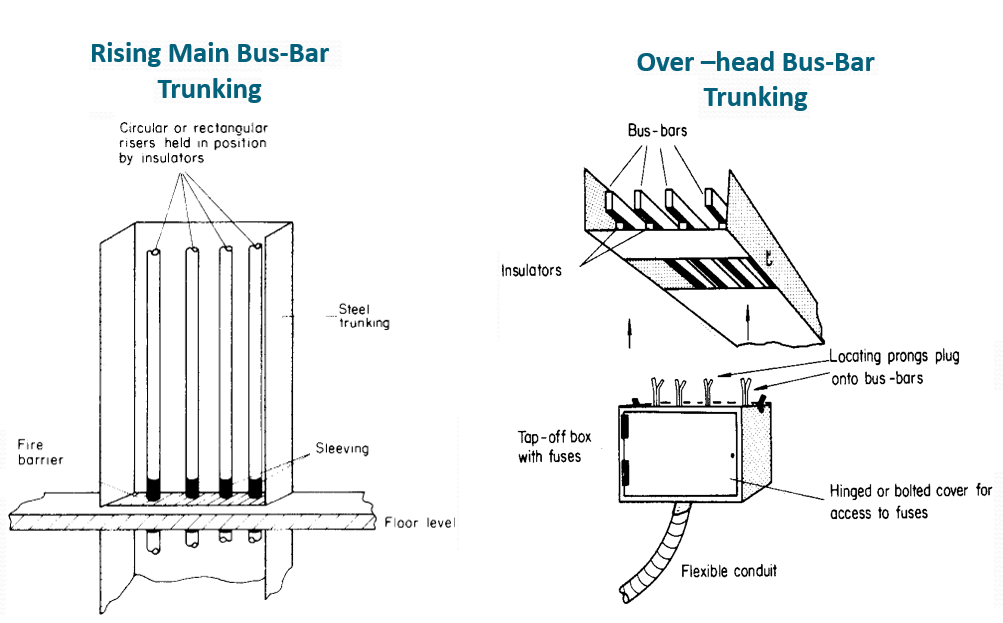
Cutting and Drilling Cables Trunking
It is often necessary to cut or drill trunking.
After cutting, all edges should be filed to remove sharp metal edges.
Burrs left after the drilling of a hole should also be filed away.
When high-speed twist drills are being used, a lubricant should be applied; this aids the drilling process and prolongs the life of the drill.
A lard oil such as tallow is recommended for use with steel. (No lubricant is needed when drilling PVC.)
It is often necessary to cut large holes in order to connect conduit into the trunking system; this may be achieved by the use of a circular hole saw or a pressure-type hole cutter.
After cutting, all hole edges must be filed smooth and conduit entries Bushed.
Segregation of Cables
Where an installation comprises a mixture of low-voltage and very low voltage circuits such as mains lighting and power, fire alarm and telecommunication circuits, they must be separated or segregated to prevent electrical contact (IEE Regulation 528.1).
For the purpose of these regulations various circuits are identified by one of two bands as follows:
Band I: telephone, radio, bell, call and intruder alarm circuits, emergency circuits for fire alarm and emergency lighting.
Band II: mains voltage circuits.
Important: Multi-compartment PVC trunking cannot provide band segregations since there is no metal screen between the Bands. This can only be provided in PVC trunking if screened cables are drawn into the trunking.
Single Compartment Trunking: Can be used when one type of cable i.e. electrical or data or telephone cables.
Double Compartment Trunking: Can be used when two type of source cable i.e. electrical & data cables or electrical & telephone cables.
Triple Compartment Trunking: Can be used when all three types of source cable i.e. electrical, data, and telephone cables.

Construction of Electrical Trunking
A trunking is an enclosure provided for the protection of cables which is normally square or rectangular in cross-section, having one removable side.
Trunking may be thought of as a more accessible conduit system and for industrial and commercial installations it is replacing the larger conduit sizes.
A trunking system can have great flexibility when used in conjunction with conduit; the trunking forms the background or framework for the installation, with conduits running from the trunking to the point controlling the current using apparatus.
When an alteration or extension is required it is easy to drill a hole in the side of the electrical trunking and run a conduit to the new point.
The new wiring can then be drawn through the new conduit and the existing trunking to the supply point.


Cable Trunking Supports
Trunking may be secured direct to a surface or suspended by means of brackets.
As trunking material is thin, there is no room for countersunk holes.
Roundhead screws are suggested, unless of course the fixing surface requires bolts.
There are occasions when the trunking has to be suspended by means of brackets.
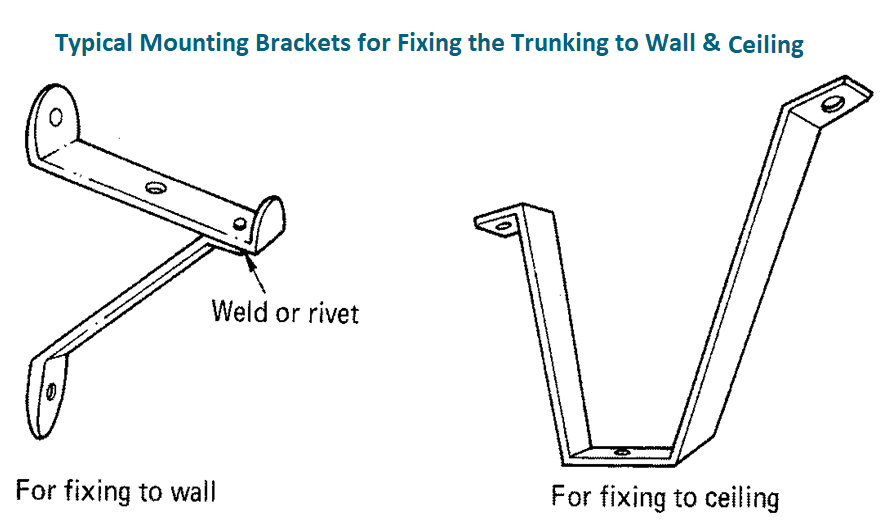
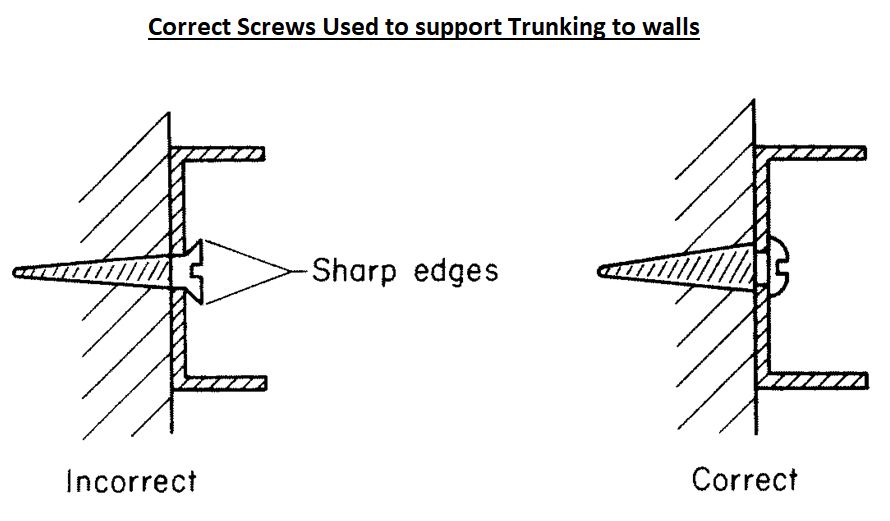
Space Factor in Trunking
The ratio of the space occupied by all the cables in a conduit or trunking to the whole space enclosed by the conduit or trunking is known as the space factor.
Space factor for cables within a trunking should not exceed 45%, this means that the cables must not fill more than 45% of the space enclosed by the trunking.
Calculating Space Factor
To calculate the size of trunking required to enclose a number of cables:
Identify the cable factor for the particular size of conductor. See Table Below.
Multiply the cable factor by the number of conductors to give the sum of the cable factors.
Consider the factors for trunking and shown in Table below.
The correct size of trunking to accommodate the cables is that trunking which has a factor equal to or greater than the sum of the cable factors.
Table: Trunking, Cable Factors. Adapted from the IEE On Site Guide
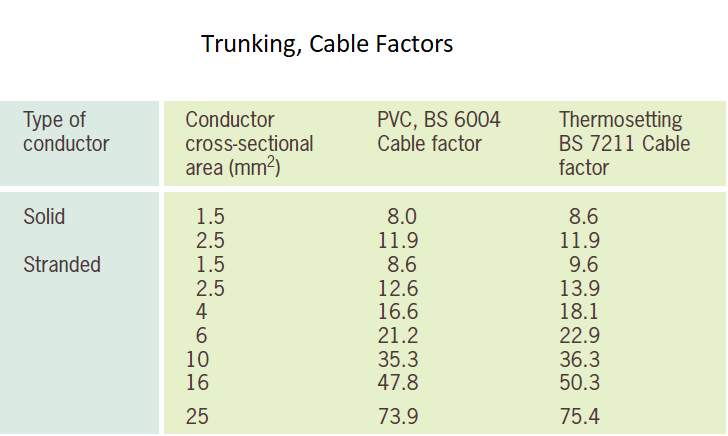
Notes:
(i) These factors are for metal trunking and may be optimistic for plastic trunking where the cross-sectional area available may be significantly reduced from the nominal by the thickness of the wall material.
(ii) The provision of spare space is advisable; however, any circuits added at a later date must take into account grouping
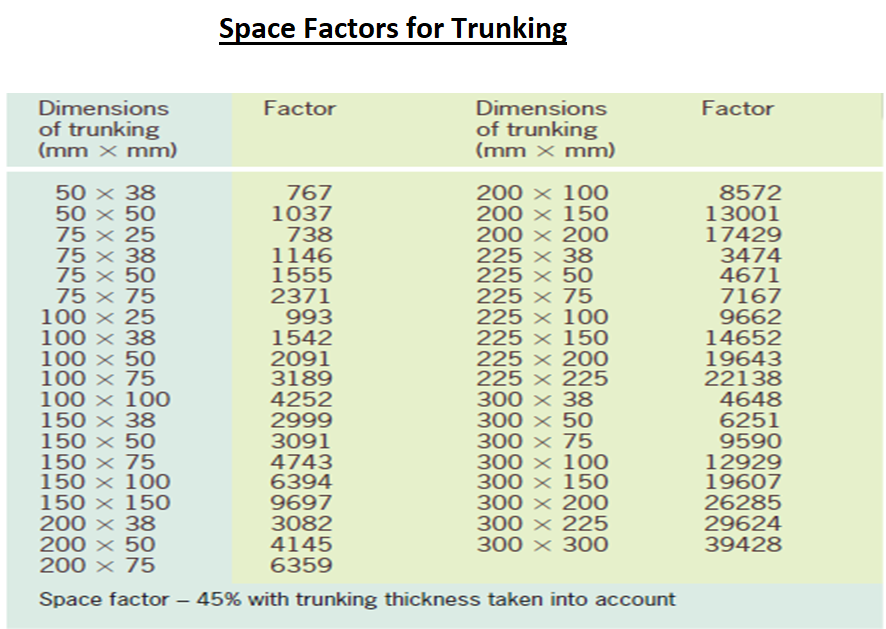
Application of Trunking System
Trunking can be for both indoors and outdoors , ranging from domestic, commercial and industrial purpose.
Many applications includes decorative skirting in homes, lighting fixtures in restaurants and departments stores etc.
Discover more from Electrical Engineering 123
Subscribe to get the latest posts sent to your email.

